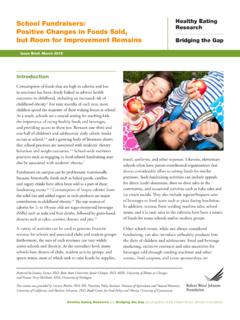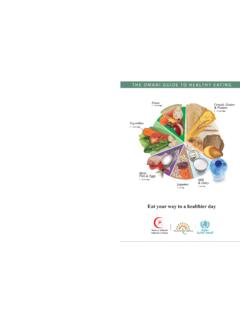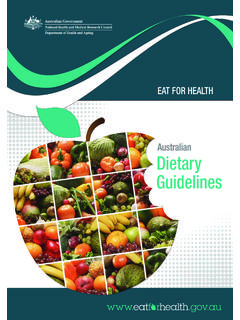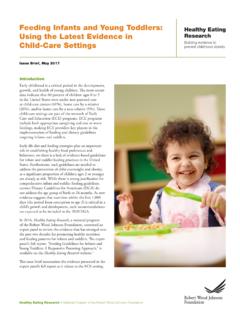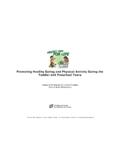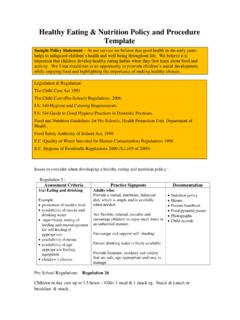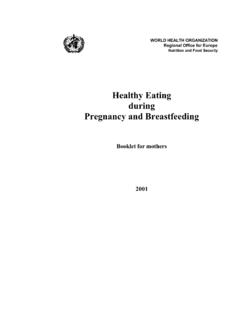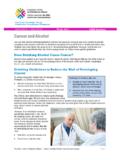Transcription of Ministry Of Health Of Brazil - Food Politics by …
1 Virtual Health Library of the Ministry of 788533 421769 ISBN 978-85-334-2176-9 Ministry OF Health OF BRAZIL2 EditionBras lia DF2014 DIETARY guidelines FOR THE BRAZILIAN POPULATION Ministry Of Health Of Brazil DIETARY guidelines FOR THE BRAZILIAN POPULATION 2 Edition1. DIETARY guidelines FOR THE BRAZILIAN POPULATIONDIETARY guidelines FOR THE BRAZILIAN POPULATIONMINISTRY OF Health OF BRAZILS ecretariat of Health CarePrimary Health Care DepartmentBras lia DF20142 EditionFormulation, distribution and information: Ministry OF Health OF BRAZILS ecretariat of Health CarePrimary Health Care DepartmentEdif cio Premium, SAF Sul, Quadra 2,lotes 5/6, bloco II, subsoloCEP: 70070-600 Bras lia/DFFone: (61) 3315-9031E-mail: editor:Eduardo Alves MeloTechnical Coordination:Patr cia Constante JaimeGeneral Coordination of Food and Nutrition Ministry of HealthTechnical Formulation.
2 Carlos Augusto MonteiroCenter for Epidemiological Research in Nutrition and Health , University of S o PauloTechnical Collaboration:General Coordination of Food and Nutrition Ministry of HealthAna Carolina Feldenheimer da SilvaAna Luisa Souza de PaivaBruna Pitasi ArguelhesFernanda RauberGisele Ane BortoliniKelly Poliany de Souza AlvesKimielle Cristina SilvaLorena Toledo de Ara jo MeloMara Lucia dos Santos CostaRenata Guimar es Mendon a de SantanaCenter for Epidemiological Research in Nutrition and Health , University of S o Paulo (NUPENS/USP)Ana Paula B. MartinsCarla Adriano MartinsCarlos Augusto Monteiro (Coordinatorenador)Daniela Silva CanellaDenise C. CoitinhoEnrique JacobyFrancine LimaGeoffrey CannonJean-Claude MoubaracJosefa Maria F.
3 GarzilloLarissa Galastri BaraldiMaluh BarciotteMaria Laura da Costa LouzadaRafael Moreira ClaroRegina RodriguesRenata Bertazzi LevySem ramis Martins lvares Domene Pan-American Health Organization Ana Carolina Feldenheimer da SilvaJanine Giuberti CoutinhoEditorial Coordination:Laeticia Jensen EbleMarco Aur lio SantanaGraphic Design and artwork:S vio MarquesFotogra as:Department of Primary Care Collection University of S o Paulo CollectionNormalization:Daniela Ferreira Barros da Silva Editora MS/CGDI2014 Ministry of Health of BrazilThis work is provided under the terms of this Creative Commons Public License Attribution NonCommercial ShareAlike International Public License. It allowed the partial or total reproduction of this work provided that the source is mentionedThe Ministry of Health s institutional collection may be accessed, in its totality, at the Virtual library of the Ministry of Health : < >.
4 CONTENTSP reface Preamble Introduction Chapter 1 Principles Chapter 2 Choosing foods Chapter 3 From foods to meals Chapter 4 Modes of eating Chapter 5 Understanding and overcoming obstacles Ten steps to healthy dietsHow to know more Annex A Process of preparation of the new edition of the Food Guide571115255391103125131143 Print run: 1st edition 2014 exemplaresCataloguing Data_____Brazil. Ministry of Health of Brazil . Secretariat of Health Care. Primary Health Care Department. Dietary guidelines for the Brazilian population / Ministry of Health of Brazil , Secretariat of Health Care, Primary Health Care Department ; translated by Carlos Augusto Monteiro Bras lia : Ministry of Health of Brazil , 2014. 156 p. : il. ISBN 978-85-334-2176-9 1.
5 Policy on Food and Nutrition. 2. Diet. 3. Dietary Catalogin - General Coordination for Documents and Information - MS Publishing House - OS 2014/0536 Index titles:Portuguese: Guia Alimentar para Popula o BrasileiraSpanish: Gu a alimentaria para la poblaci n brasile aPrinted in Brazil54 Ministry OF Health para a Popula o Brasileira PREFACE During the last decades, Brazil has undergone several political, economic, social and cultural transformations that in turn resulted in changes in the lifestyle of the population. The expansion of social policies in Health , education, labour and employment and social assistance contributed to reducing social inequalities and allowed the country to grow in an inclusive manner. Rapid demographic, epidemiological and nutritional transition was also observed, and as a consequence other indicators were DOVR LQ XHQFHG VXFK DV D KLJKHU OLIH H[SHFWDQF\ DQG D UHGXFHG number of offspring per woman, as well as important changes in Health and food consumption patterns of the population.]
6 The main diseases that currently affect the Brazilians are no longer acute but chronic. Despite the expressive decrease in PDOQXWULWLRQ LQ FKLOGUHQ PLFURQXWULHQW GH FLHQFLHV DQG FKURQLF malnutrition are still prevalent in vulnerable population groups, such as Indians, Maroons, and children and women living in vulnerable areas. At the same time, Brazil is experiencing a VLJQL FDQW LQFUHDVH RI RYHUZHLJKW DQG REHVLW\ LQ DOO DJH JURXSV and chronic diseases are the leading cause of death among adults. Now, one in two adults and one in three Brazilian children are overweight. To tackle this scenario, there is an increasing need to expand intersectoral actions that resonate positively on the various determinants of Health and nutrition.
7 In this context, the Health sector plays an important role in promoting adequate and healthy eating, which is already an expressed commitment in the National Food and Nutrition Policy and the National Health Promotion Policy. Promoting healthy eating in the Sistema nico de Sa de (SUS) the Brazilian national Health system must be 76 Ministry OF Health based on the dimensions of encouragement, support and protection of Health , and must combine initiatives focused on healthy public policies, on creating healthy environments, on developing personal skills and on reorienting Health services from the perspective of Health promotion. The Dietary guidelines for the Brazilian Population, published in 2006, SUHVHQWHG WKH UVW RI FLDO GLHWDU\ JXLGHOLQHV IRU RXU SRSXODWLRQ *LYHQ WKH social changes experienced by Brazilian society, which impacted people s Health and nutrition conditions, the presentation of new recommendations became necessary.
8 The second edition of the Dietary guidelines for the Brazilian Population was submitted to a public consultation process that allowed its broad debate by various sectors of society and guided the FRQVWUXFWLRQ RI WKH QDO YHUVLRQ ZKLFK LV SUHVHQWHG KHUH Assuming the rights to Health and healthy food as general assumptions, WKH *XLGH LV DQ RI FLDO GRFXPHQW WKDW DGGUHVVHV WKH SULQFLSOHV DQG recommendations of a healthy diet for the Brazilian population, representing a tool to support food and nutrition educational activities in SUS and also in other sectors. Considering the multiple determinants of feeding practices and the complexity and challenges that are involved in the shaping of current food systems, the Food Guide reinforces the commitment of the Ministry of Health to contribute to the development of strategies for the promotion and realization of the human right to adequate food.
9 Ministry of HealthPREAMBLEThe World Health Organization (WHO) recommends, in its Global Strategy on Diet, Physical Activity and Health , that governments formulate and periodically revise national guidelines on food and nutrition. Revised and updated versions should take into account changes in population dietary patterns and states of Health and disease, and also progress of VFLHQWL F NQRZOHGJH 7 KHVH *XLGHOLQHV DUH DLPHG DW VXSSRUWLQJ IRRG DQG nutrition education actions and national food and nutrition programmes and policies in Brazil . Creation of dietary guidelines is part of a set of several national intersectoral actions that aim to improve the standards of diet and nutrition of the population and contribute toward promoting Health .
10 WHO therefore proposes that governments provide information and guidance to facilitate healthier food choices and habits, taking into account national and local food cultures, written for everybody and presented clearly and part of the Brazilian government s responsibility to promote the nation s Health and food and nutrition security, the Ministry of Health published Dietary guidelines for the Brazilian Population - Promoting +HDOWK\ (DWLQJ LQ 7 KHVH ZHUH WKH UVW RI FLDO QDWLRQDO GLHWDU\ guidelines . They became a reference for people, families, communities, Health professionals and government at all levels in promoting proper and healthy line with WHO s recommendation for periodic revision, in 2011 the Ministry of Health began the process of developing a new edition of the Dietary guidelines for the Brazilian Population.)


